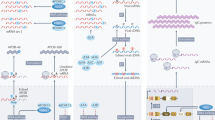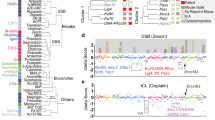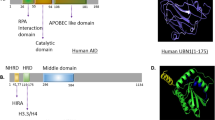Abstract
Somatic hypermutation and class switch recombination are DNA modification reactions that alter the genes encoding antibodies in B lymphocytes. Both of these distinct reactions require activation-induced deaminase (AID) and transcription. Here we show that in Escherichia coli, as in eukaryotic cells, the mutation frequency is directly proportional to the transcription of target genes. Transcription enhances mutation of the nontemplate DNA strand, which is exposed as single-stranded DNA during the elongation reaction, but not mutation of the template DNA strand, which is protected by E. coli RNA polymerase. Our results establish a direct link between AID and transcription and suggest that the role of transcription in facilitating mutation is to provide AID with access to single-stranded DNA.
This is a preview of subscription content, access via your institution
Access options
Subscribe to this journal
Receive 12 print issues and online access
$209.00 per year
only $17.42 per issue
Buy this article
- Purchase on Springer Link
- Instant access to full article PDF
Prices may be subject to local taxes which are calculated during checkout



Similar content being viewed by others
Accession codes
References
Stavnezer, J. Antibody class switching. Adv. Immunol. 61, 79–146 (1996).
Matsuoka, M., Yoshida, K., Maeda, T., Usuda, S. & Sakano, H. Switch circular DNA formed in cytokine-treated mouse splenocytes: evidence for intramolecular DNA deletion in immunoglobulin class switching. Cell 62, 135–142 (1990).
Iwasato, T., Shimizu, A., Honjo, T. & Yamagishi, H. Circular DNA is excised by immunoglobulin class switch recombination. Cell 62, 143–149 (1990).
von Schwedler, U., Jack, H.M. & Wabl, M. Circular DNA is a product of the immunoglobulin class switch rearrangement. Nature 345, 452–456 (1990).
Rolink, A., Melchers, F. & Andersson, J. The SCID but not the RAG-2 gene product is required for Sμ-S epsilon heavy chain class switching. Immunity 5, 319–330 (1996).
Manis, J.P. et al. Ku70 is required for late B cell development and immunoglobulin heavy chain class switching. J. Exp. Med. 187, 2081–2089 (1998).
Casellas, R. et al. Ku80 is required for immunoglobulin isotype switching. EMBO J. 17, 2404–2411 (1998).
Petersen, S. et al. AID is required to initiate Nbs1/γ-H2AX focus formation and mutations at sites of class switching. Nature 414, 660–665 (2001).
Muramatsu, M. et al. Class switch recombination and hypermutation require activation-induced cytidine deaminase (AID), a potential RNA editing enzyme. Cell 102, 553–563 (2000).
Petersen-Mahrt, S.K., Harris, R.S. & Neuberger, M.S. AID mutates E. coli suggesting a DNA deamination mechanism for antibody diversification. Nature 418, 99–103 (2002).
Revy, P. et al. Activation-induced cytidine deaminase (AID) deficiency causes the autosomal recessive form of the hyper-IgM syndrome (HIGM2). Cell 102, 565–575 (2000).
Arakawa, H., Hauschild, J. & Buerstedde, J.M. Requirement of the activation-induced deaminase (AID) gene for immunoglobulin gene conversion. Science 295, 1301–1306 (2002).
Harris, R.S., Sale, J.E., Petersen-Mahrt, S.K. & Neuberger, M.S. AID is essential for immunoglobulin V gene conversion in a cultured B cell line. Curr. Biol. 12, 435–438 (2002).
Okazaki, I.M., Kinoshita, K., Muramatsu, M., Yoshikawa, K. & Honjo, T. The AID enzyme induces class switch recombination in fibroblasts. Nature 416, 340–345 (2002).
Yoshikawa, K. et al. AID enzyme-induced hypermutation in an actively transcribed gene in fibroblasts. Science 296, 2033–2036 (2002).
Martin, A. et al. Activation-induced cytidine deaminase turns on somatic hypermutation in hybridomas. Nature 415, 802–806 (2002).
Teng, B., Burant, C.F. & Davidson, N.O. Molecular cloning of an apolipoprotein B messenger RNA editing protein. Science 260, 1816–1819 (1993).
Di Noia, J. & Neuberger, M.S. Altering the pathway of immunoglobulin hypermutation by inhibiting uracil-DNA glycosylase. Nature 419, 43–48 (2002).
Rada, C. et al. Immunoglobulin isotype switching is inhibited and somatic hypermutation perturbed in UNG-deficient mice. Curr. Biol. 12, 1748–1755 (2002).
Faili, A. et al. Induction of somatic hypermutation in immunoglobulin genes is dependent on DNA polymerase ι. Nature 419, 944–947 (2002).
Zeng, X. et al. DNA polymerase ε is an A-T mutator in somatic hypermutation of immunoglobulin variable genes. Nat. Immunol. 2, 537–541 (2001).
Rogozin, I.B., Pavlov, Y.I., Bebenek, K., Matsuda, T. & Kunkel, T.A. Somatic mutation hotspots correlate with DNA polymerase ε error spectrum. Nat. Immunol. 2, 530–536 (2001).
Zan, H. et al. The translesion DNA polymerase ζ plays a major role in Ig and Bcl-6 somatic hypermutation. Immunity 14, 643–653 (2001).
Wiesendanger, M., Kneitz, B., Edelmann, W. & Scharff, M.D. Somatic hypermutation in MutS homologue (MSH)3-, MSH6-, and MSH3/MSH6-deficient mice reveals a role for the MSH2-MSH6 heterodimer in modulating the base substitution pattern. J. Exp. Med. 191, 579–584 (2000).
Schrader, C.E., Edelmann, W., Kucherlapati, R. & Stavnezer, J. Reduced isotype switching in splenic B cells from mice deficient in mismatch repair enzymes. J. Exp. Med. 190, 323–330 (1999).
Rada, C., Ehrenstein, M.R., Neuberger, M.S. & Milstein, C. Hot spot focusing of somatic hypermutation in MSH2-deficient mice suggests two stages of mutational targeting. Immunity 9, 135–141 (1998).
Kim, N., Bozek, G., Lo, J.C. & Storb, U. Different mismatch repair deficiencies all have the same effects on somatic hypermutation: intact primary mechanism accompanied by secondary modifications. J. Exp. Med. 190, 21–30 (1999).
Goyenechea, B. et al. Cells strongly expressing Igκ transgenes show clonal recruitment of hypermutation: a role for both MAR and the enhancers. EMBO J. 16, 3987–3994 (1997).
Peters, A. & Storb, U. Somatic hypermutation of immunoglobulin genes is linked to transcription initiation. Immunity 4, 57–65 (1996).
Fukita, Y., Jacobs, H. & Rajewsky, K. Somatic hypermutation in the heavy chain locus correlates with transcription. Immunity 9, 105–114 (1998).
Stavnezer, J. Immunoglobulin class switching. Curr. Opin. Immunol. 8, 199–205 (1996).
Stavnezer-Nordgren, J. & Sirlin, S. Specificity of immunoglobulin heavy chain switch correlates with activity of germline heavy chain genes prior to switching. EMBO J. 5, 95–102 (1986).
Yancopoulos, G.D. et al. Secondary genomic rearrangement events in pre-B cells: VHDJH replacement by a LINE-1 sequence and directed class switching. EMBO J. 5, 3259–3266 (1986).
Gu, H., Zou, Y.R. & Rajewsky, K. Independent control of immunoglobulin switch recombination at individual switch regions evidenced through Cre-loxP–mediated gene targeting. Cell 73, 1155–1164 (1993).
Jung, S., Rajewsky, K. & Radbruch, A. Shutdown of class switch recombination by deletion of a switch region control element. Science 259, 984–987 (1993).
Pinaud, E. et al. Localization of the 3′ IgH locus elements that effect long-distance regulation of class switch recombination. Immunity 15, 187–199 (2001).
Lee, C.G. et al. Quantitative regulation of class switch recombination by switch region transcription. J. Exp. Med. 194, 365–374 (2001).
Bachl, J., Carlson, C., Gray-Schopfer, V., Dessing, M. & Olsson, C. Increased transcription levels induce higher mutation rates in a hypermutating cell line. J. Immunol. 166, 5051–5057 (2001).
Betz, A.G. et al. Elements regulating somatic hypermutation of an immunoglobulin κ gene: critical role for the intron enhancer/matrix attachment region. Cell 77, 239–248 (1994).
Zhang, J., Bottaro, A., Li, S., Stewart, V. & Alt, F.W. A selective defect in IgG2b switching as a result of targeted mutation of the Iγ2b promoter and exon. EMBO J. 12, 3529–3537 (1993).
Harris, R.S., Petersen-Mahrt, S.K. & Neuberger, M.S. RNA editing enzyme APOBEC1 and some of its homologs can act as DNA mutators. Mol. Cell. 10, 1247–1253 (2002).
Kane, J.F. Effects of rare codon clusters on high-level expression of heterologous proteins in Escherichia coli. Curr. Opin. Biotechnol. 6, 494–500 (1995).
Beletskii, A. & Bhagwat, A.S. Transcription-induced mutations: increase in C to T mutations in the nontranscribed strand during transcription in Escherichia coli. Proc. Natl. Acad. Sci. USA 93, 13919–13924 (1996).
Lebecque, S.G. & Gearhart, P.J. Boundaries of somatic mutation in rearranged immunoglobulin genes: 5′ boundary is near the promoter, and 3′ boundary is approximately 1 kb from V(D)J gene. J. Exp. Med. 172, 1717–1727 (1990).
Both, G.W., Taylor, L., Pollard, J.W. & Steele, E.J. Distribution of mutations around rearranged heavy-chain antibody variable-region genes. Mol. Cell. Biol. 10, 5187–5196 (1990).
Yelamos, J. et al. Targeting of non-Ig sequences in place of the V segment by somatic hypermutation. Nature 376, 225–229 (1995).
Azuma, T., Motoyama, N., Fields, L.E. & Loh, D.Y. Mutations of the chloramphenicol acetyl transferase transgene driven by the immunoglobulin promoter and intron enhancer. Int. Immunol. 5, 121–130 (1993).
Storb, U. & Stavnezer, J. Immunoglobulin genes: generating diversity with AID and UNG. Curr. Biol. 12, R725–R727 (2002).
Shen, H.M., Peters, A., Baron, B., Zhu, X. & Storb, U. Mutation of BCL-6 gene in normal B cells by the process of somatic hypermutation of Ig genes. Science 280, 1750–1752 (1998).
Pasqualucci, L. et al. Hypermutation of multiple proto-oncogenes in B-cell diffuse large-cell lymphomas. Nature 412, 341–346 (2001).
Rogozin, I.B. & Kolchanov, N.A. Somatic hypermutagenesis in immunoglobulin genes. II. Influence of neighbouring base sequences on mutagenesis. Biochim. Biophys. Acta 1171, 11–18 (1992).
Kogoma, T. Stable DNA replication: interplay between DNA replication, homologous recombination, and transcription. Microbiol. Mol. Biol. Rev. 61, 212–238 (1997).
Tian, M. & Alt, F.W. Transcription-induced cleavage of immunoglobulin switch regions by nucleotide excision repair nucleases in vitro. J. Biol. Chem. 275, 24163–24172 (2000).
Korzheva, N. et al. A structural model of transcription elongation. Science 289, 619–625 (2000).
Darst, S.A. Bacterial RNA polymerase. Curr. Opin. Struct. Biol. 11, 155–162 (2001).
Wang, D. & Landick, R. Nuclease cleavage of the upstream half of the nontemplate strand DNA in an Escherichia coli transcription elongation complex causes upstream translocation and transcriptional arrest. J. Biol. Chem. 272, 5989–5994 (1997).
Artsimovitch, I. & Landick, R. The transcriptional regulator RfaH stimulates RNA chain synthesis after recruitment to elongation complexes by the exposed nontemplate DNA strand. Cell 109, 193–203 (2002).
Espeli, O., Moulin, L. & Boccard, F. Transcription attenuation associated with bacterial repetitive extragenic BIME elements. J. Mol. Biol. 314, 375–386 (2001).
Acknowledgements
We thank members of the Nussenzweig laboratory, F. Papavasiliou, S. Darst, P. Model and M. Russel for discussions and E. Besmer for help with the manuscript. This work was supported in part by grants from the US National Institutes of Health (to M.C.N.). M.C.N is an Howard Hughes Medical Institute Investigator, P.S. is supported by a grant from the Cancer Research Institute, and A.R.R. is a fellow of the Ministerio de Educacion, Cultura y Deporte.
Author information
Authors and Affiliations
Corresponding author
Ethics declarations
Competing interests
The authors declare no competing financial interests.
Supplementary information
Rights and permissions
About this article
Cite this article
Ramiro, A., Stavropoulos, P., Jankovic, M. et al. Transcription enhances AID-mediated cytidine deamination by exposing single-stranded DNA on the nontemplate strand. Nat Immunol 4, 452–456 (2003). https://doi.org/10.1038/ni920
Received:
Accepted:
Published:
Issue Date:
DOI: https://doi.org/10.1038/ni920
This article is cited by
-
Mutational spectrum of TP53 gene correlates with nivolumab treatment efficacy in advanced gastric cancer (TP53MUT study)
British Journal of Cancer (2023)
-
Single-stranded DNA binding proteins influence APOBEC3A substrate preference
Scientific Reports (2021)
-
ADP-dependent glucokinase as a novel onco-target for haematological malignancies
Scientific Reports (2020)
-
Distinct subtypes of diffuse large B-cell lymphoma defined by hypermutated genes
Leukemia (2019)
-
A licensing step links AID to transcription elongation for mutagenesis in B cells
Nature Communications (2018)



